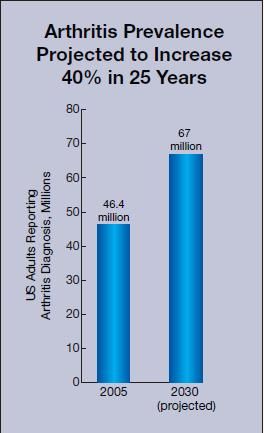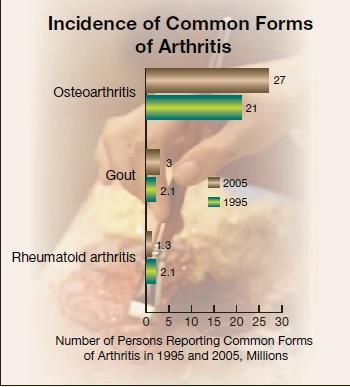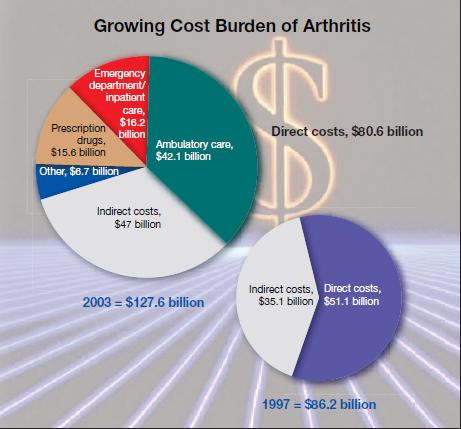Arthritis Prevalence Projected to Reach 25% by 2030
An estimated 46.4 million US adults, or approximately 21% of the adult population, self-reported a physician-diagnosed form of arthritis, which is the leading cause of disability in the United States, according to 2005 data collected by the National Arthritis Data Work group. The work group estimates that by 2030, the number of US adults aged 18 years and older with arthritis or other rheumatic conditions will jump to nearly 67 million (25% of the adult population)-an increase of about 40% (Figure 1).
An estimated 46.4 million US adults, or approximately 21% of the adult population, self-reported a physician-diagnosed form of arthritis, which is the leading cause of disability in the United States, according to 2005 data collected by the National Arthritis Data Workgroup. The workgroup estimates that by 2030, the number of US adults aged 18 years and older with arthritis or other rheumatic conditions will jump to nearly 67 million (25% of the adult population)-an increase of about 40% (Figure 1).

Figure 1. The number of persons with arthritis is expected to reach 67 million in 2030, an increase of 40% from 2005. Source: Helmick CG, Felson DT, Lawrence RC, et al. Estimates of the prevalence of arthritis and other rheumatic conditions in the United States, part I and part II. Arthritis Rheum. 2008;58:15-35.
About 27 million US adults have osteoarthritis, one of the most common forms of arthritis, an increase from the 1995 estimate of 21 million adults (Figure 2). Rheumatoid arthritis affects 1.3 million US adults, a decline from the estimated 2.1 million adults in 1995 resulting from a combination of more restrictive classification criteria and a drop in prevalence. Approximately 3 million US adults had self-reported gout in 2005, an increase from the 1995 estimate of 2.1 million adults with the condition.

Figure 2. The incidence of osteoarthritis and gout increased significantly between 1995 and 2005, while that of rheumatoid arthritis declined in part because of more restrictive classification criteria. Source: Helmick CG et al. Arthritis Rheum. 2008;58:15-35.
The workgroup also estimated the 2005 incidence of other rheumatic conditions. An estimated 5 million US adults have fibromyalgia, and between 4 million and 10 million US adults have carpal tunnel syndrome.
Although the workgroup did not study costs, direct and indirect costs attributed to arthritis were $127.6 billion in 2003, up from $86.2 billion in 1997 (Figure 3).

Figure 3. Medical expenditures for arthritis are rising more rapidly than indirect costs (lost earnings). Source: Centers for Disease Control and Prevention. National and state medical expenditures and lost earnings attributed to arthritis and other rheumatic conditions-United States, 2003. MMWR. 2007;56:4-7.
An estimated 8.8% of US adults, or nearly 19 million, self-reported arthritis-attributable activity limitations in 2005. This outcome is projected to increase to 9.3% of US adults (25 million) by 2030.